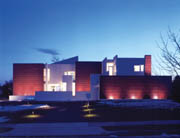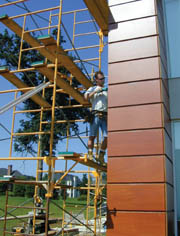
It was along those lines that Stephen Varenhorst Architects, of Conshohocken, Pa., designed the Silverman residence.
"Since the client was focused on an environment that was natural and healthy," explains Architect Stephen Varenhorst, "we looked to systems that would promote that and reduce moisture problems-which led to the exterior wall panel."
Natural reaction
The Silvermans hired Varenhorst on a recommendation. They asked for a very modern design that would incorporate the desired moisture prevention components.
Also, they wanted an open floor plan with lots of windows to bring the outdoors in. The house includes a master bed suite and three other bedrooms, a living room/home theater, main dining room, kitchen and upper and lower level family rooms. The basement includes an exercise room, playroom, storage, and another bathroom and shower for the exercise area.
Also, running through the house is the theme of water, water at the front entrance, a large aquarium 12 feet long and 3 feet deep, and a koi pond outside the window of the dining room.
"Modern design isn't necessarily anti-nature," Varenhorst says. "They wanted to live in a more natural way."
Despite the presence of so much water, Varenhorst still needed to design a wall system that would result in the desired moisture prevention the family sought. Varenhorst used a pre-surfaced, multi-purpose plywood panel to design a rain screen system.

The rubber meets the wall
The exterior wall panel is part of a building system, a rain screen building specified by Varenhorst. Although EIFS uses the word rain screen it is not quite a rain screen system the way the Silverman residence is."The wall system from the inside out is as follows," Varenhorst explains. "Drywall, 2x6 wood studs and 3/4-inch plywood as sheathing. On top of the sheathing is a rubber membrane that serves as a water barrier. On top of the membrane are 3 inches of semi-rigid insulation, 11⁄2 inches of air space and then the wood panel itself on the exterior."
The panel, manufactured by Finland Color Plywood Corp., of Venice, Calif., is presurfaced on both sides with a smooth colored translucent film. The natural wood grain is visible through the translucent color surface, making each panel different. The panels are a natural material, with variations in color, grain and tone. Individual panels may vary in the luster or matte character of their finish, giving each panel a different depth of tone.
The panels are constructed of Finland birch hardwood veneers and are a composite panel: a wood veneer with 3/8-inch solid resin-like material sandwiched between, which makes it rigid and stiff.
They are pre-surfaced and ready for use. Combined with Varenhorst's specifications, the exterior is a ventilated rain screen system.
"Any condensation that would occur in the insulation occurs outside the building envelope and is ventilated away through the airspace," he adds. "All the horizontal lines visible on the panel installation are functional: Air flows though the reveal and that's how the whole wall is ventilated."
Ultimately, the firm used this system because of its ability to keep moisture outside of the building envelope, again to prevent a buildup of allergens. Varenhorst also says the system is very energy efficient because by wrapping the building, there are no breaks in the insulation, like in a stud wall. It's designed to be a very efficient use of insulation.
In the construction process, the contractor worked with the architect to fabricate the walls. Together, contractor and architect sort out some of the details of the fabrication.
"Contractor Chiles and Sillivan Inc. did a really good job of pulling the details together," Varenhorst says. "We worked together to figure out the details and some field applications required we build sample panels. This is a system we designed-it's unique-and we worked out some of the details in the field. But this system was specifically fabricated for the Silverman house."
Although rain screens have been around, they're more common in Europe than the United States. Varenhorst thinks it's catching on in some areas, although more in commercial construction, as it's more of a "high-end type of installation."


